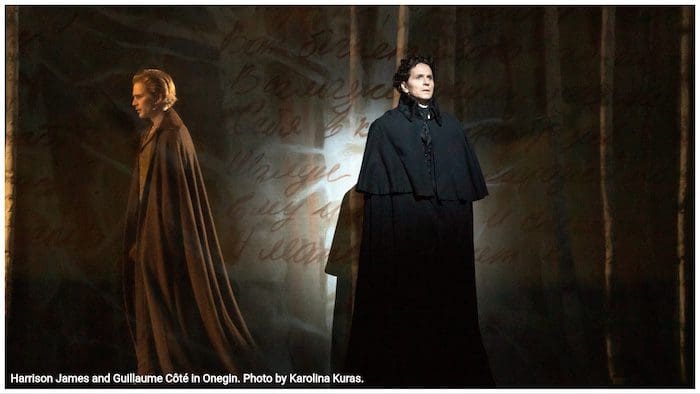My love of the National Ballet of Canada started when I saw them dance Onegin. It was a very different company back in 2010 when this production made its debut with Santo Loquasto’s rich and moody redesign and the starriest of all-star casts for opening night, but the Onegin magic is alive and well even as the company enters a rebuilding phase after the retirement of renowned artistic director Karen Kain and the departure of a number of company stars.
Steadfast leading man Guillaume Côté is the lone cast member who performed at both that landmark debut and the current run’s opening night. As the company makes their way through their tentpole repertoire, the National Ballet is currently announcing every major role as “Guillaume Côté’s final _____”, swiftly adding a ‘don’t worry, he’s not retiring yet!’ message to the releases, the implication being that while he’s not retiring right now, he will likely be retired by the time this rep comes back around. Though he will surely stay involved with the National in some capacity even after his dancing days are done (Côté is also an established choreographer and the AD of his own company), it’s hard not to lament the not-yet-but-soon-ish loss of his finesse and reliability as a performer. With eleven more years experience than the next longest tenured male principal, Côté (along with his wife Heather Ogden) represents a generational bridge between the now-departed legends of the company’s heyday under Kain and the up-and-coming dancers looking to prove themselves during Hope Muir’s just-begun tenure. It’s telling that he is the sole performer dancing the title role during this 7-show run who has ever danced it before.
Though he’d play the title role later in that 2010 run, in the premiere cast Côté danced the role of Lensky opposite Ogden’s Olga (Ogden dances Tatiana in this run, opposite Chritopher Gerty’s debut as Onegin Nov 23 & 26). One of the things I love most about choreographer John Cranko’s sublime setting of Pushkin’s epic story is that, despite the iconic status of the dramatic title character, there’s actually a really intriguing balance to the principal cast. While many ballets fall into a simple hierarchy of leading and supporting roles, Onegin allows for more nuanced casting and demands brilliant performers for all five main characters, not just the top two. Lensky, in particular, has such depth of character and thrilling dance sequences that he’s regularly played by a principal of close or comparable stature to Onegin.
In a perfect example, in this run, he’s Harrison James. It’s far from a stretch to say that, if the company is able to hold on to him, James is Côté’s heir apparent as the onstage face of the National Ballet. He’s the second most prominent male dancer at NBoC, a favourite with audiences for his grace and charm, and distinguished particularly for his partnering skills. His technique and acting absolutely qualify James for the famous title role but he’s a perfect Lensky so it’s heartening to see the company give that character the respect of casting a performer of James’ stature rather than piling all the highest ranking dancers on Onegin.
Severe and selfish, the title role of Onegin actually demands the opposite of the qualities of most classical ballet leading men. Cranko’s bold, story-driven choreography uses partnering to beautifully illustrate character, contrasting Onegin’s detached placement of his partner with Lensky (and, even more pointedly, Prince Gremin)’s attentive and connected style. As such, I’ve often found my favourite Onegins are not actually the company’s usual leading men but rather the slightly more unique and intense performers more suited to complicated kings than princes charming. An all-time great Prince Charming, Côté’s technically excellent performance in the title role left me feeling as though the company has lost too many contrasting performers in recent years, leaving a natural Lensky as the only experienced Onegin. Côté’s Stanley Kowalski gave me the same feeling, as though the natural charisma that so strongly endears him to the audience stands a bit in the way of colder characters. His maturity is an asset in the role, however, and I’m intrigued to hear how the younger company members fare as they take on the role for the first time.
The female characters represent a somewhat simpler A/B casting paradigm with a much more substantial gap in material between leading lady Tatiana and her charming sister Olga. The outgoing sister is still key, however, and the NBoC seems to have smartly identified the bright spitfires in their capable roster of female dancers to bring the necessary liveliness to Olga. On opening night, Tina Pereira shone in the supporting role, her energy contrasting beautifully with Jurgita Dronina‘s understated and elegant Tatiana.
It’s an odd time for the National Ballet, a sort of in-between moment while the company develops the bench depth necessary to be able to cast with more thought to character type rather than strictly technical proficiency. It’s a privilege to have a talent like Côté that the company can lean on to execute any role to a high standard but a more consistently strong roster representing a wider diversity of style and presence will make unique pieces like Onegin far more impactful.

